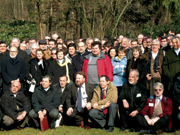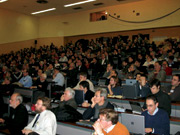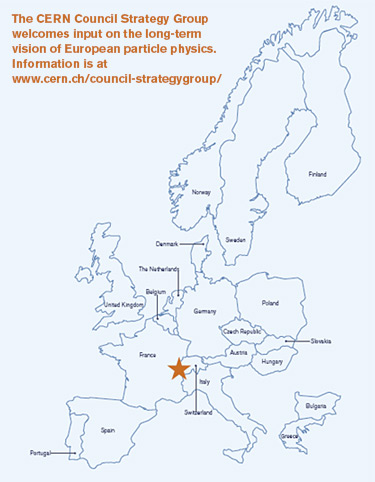Essay: James Gillies
CERN strategy group
CERN, the laboratory, has its home outside Geneva, Switzerland, but CERN, the organization, is a much broader collaboration, involving all of Europe. The Council of CERN is seeking input on developing a long-term vision for European particle physics.
|
|||||||||
CERN Strategy Group develops a vision for European particle physics
The future of particle physics in Europe was top of the agenda in the French university town of Orsay at the end of January. Some 400 European particle physicists, joined by representatives of the particle physics communities of North America and Asia, and a remote audience of more than 70, came together to discuss the future, and to give their input to the recently-formed CERN Council Strategy Group. Established by the CERN Council in 2005, the Strategy Group is charged with preparing a long-term vision for European particle physics for presentation to a special meeting of the CERN Council in July.
When CERN was founded over half a century ago, it was Europe’s first scientific joint venture. Its founding convention mandated the new organization to “provide for collaboration among European States in nuclear research of a pure scientific and fundamental character,” and went on to charge the organization with the establishment of one or more international laboratories where this research would be carried out. By 1954, Geneva had been chosen as the seat of the new organization, and construction of a new laboratory was underway. In 1959, CERN’s first big accelerator, the Proton Synchrotron, was commissioned.
For a brief period in the late 1960s and early 1970s, sites elsewhere in Europe were studied for a new CERN venture, the 300-GeV project, which became the Super Proton Synchrotron (SPS). But the inexorable logic of building on existing infrastructure won the day and the SPS was built in Geneva. Briefly operated as CERN Lab 2, it was soon integrated into the existing laboratory. Since then, the name CERN has become synonymous with the famous laboratory on the Franco-Swiss border outside Geneva.
The CERN laboratory has developed into a world-class facility with a proud track record, and its member states have grown from the original 12 to 20 today. Over the same period, CERN’s members have pursued their own agendas with important national laboratories and thriving domestic programs making use of CERN’s facilities, as well as pursuing complementary lines of research.
In 2005, with the growing globalization of particle physics, the CERN Council decided to establish the Strategy Group to prepare a long-term vision for particle physics in Europe, consistent with the provisions of the CERN Convention. Chaired by Ken Peach, chair of CERN’s Scientific Policy Committee (SPC), and Torsten Åkesson, chair of the European Committee for Future Accelerators (ECFA), the group will report to the CERN Council in Lisbon on July 14, 2006. This development restores the distinction between CERN, the famous laboratory, and CERN, the European Organization for Nuclear Research. “We must be clear,” explained Åkesson, “that this is an inclusive process involving the whole of Europe’s particle physics community. With 20 member state delegations, the CERN Council is the natural body to take a broad view of the future direction of European particle physics.”
The Strategy Group consists of one particle physicist nominated by each of the Council’s 20 delegations, the directors of the major particle physics laboratories in CERN’s member states, and a number of particle physicists from the SPC and ECFA, with a scientific secretary from CERN. Its aim is to build on Europe’s strengths: at CERN, in national laboratories, and in university groups and institutes.
The approach that Åkesson and Peach have taken is to invite input from members of the European particle-physics community about their wishes and aspirations, while at the same time studying existing European and global infrastructure to see how Europe can best contribute to the future of particle physics on the world scale. “If we are to propose a strategy for the future of particle physics in Europe,” explained Peach, “we can’t operate in a vacuum. We have to listen to what the community wants, particularly the younger members, since this will be their strategy.”
This was the motivation for the Orsay symposium. There was a presentation on each topic of interest that led into an extended discussion, with more time set aside for the discussions than for the presentations. The result was a feast of lively debate—witness to a vibrant community full of ideas for an exciting future in this increasingly globalized field. Major infrastructures, such as the proposed International Linear Collider, upgrades to the Large Hadron Collider, and future neutrino factories took much of the time, but the discussions were not limited to the frontier machines. Subtle experiments, such as those searching for rare phenomena, which require modest apparatus and the quiet environment of deep underground laboratories, were also on the agenda. One key message that emerged is that whatever the future holds, it is physics that must lead the way. Science will determine the community’s priorities, rather than letting choices be determined by technology.
The Strategy Group now has the formidable task of distilling all this into a draft strategy document to be presented to the CERN Council in Lisbon on July 14. With the Council being formed by representatives of the governments and particle physics communities of 20 European states, this will be a truly European strategy, in line with the spirit of the founding fathers of Europe’s first scientific international organization.
James Gillies
James Gillies is the head of the CERN communication group.
Click here to download the pdf version of this article.





